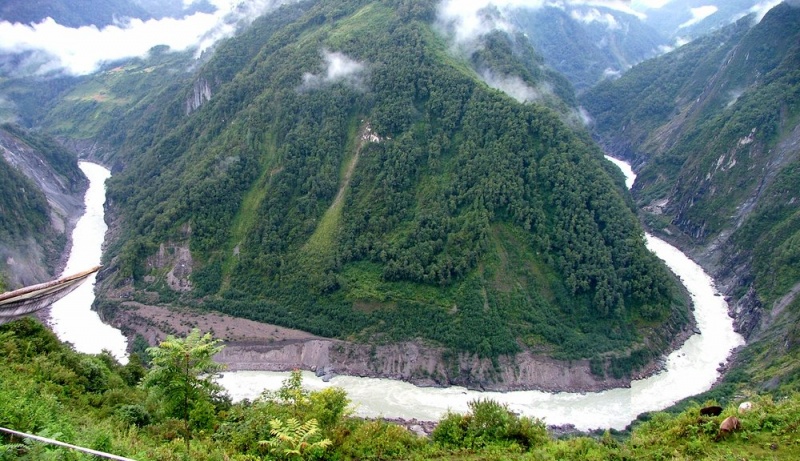The Yarlung Tsangpo-Siang-Brahmaputra-Jamuna system, spanning from Tibet to Bangladesh, stands as a monumental marvel among the world’s grandest rivers.
Encompassing a vast basin of 274,918 square miles across three nations, this majestic watercourse weaves through diverse landscapes, flowing from towering mountain ranges to expansive plains with breathtaking fluidity.
The Brahmaputra basin, located in northeast India, is a crucial region within the Indo-Burma biodiversity hotspot, recognized by the International Union for Conservation of Nature (IUCN) as one of the 25 mega-biodiversity hotspots.
Its unique physiographic and climatic features make it India’s richest repository of biodiversity. Indigenous communities in Arunachal and Assam depend on the basin’s fertile alluvial soil for cultivating essential crops, showcasing a harmonious relationship with the environment as they utilize handcrafted boats for fishing.
The Brahmaputra River has historically been integral to livelihoods in Assam, supporting agriculture and serving as a vital transport route long before railways. In 1844, the India General Navigation and Railway Company Ltd inaugurated a steamship service, enhancing connectivity and trade between present-day Bangladesh and Assam through efficient waterway transportation.
However, climate change has brought heightened challenges to farming and fishing communities in the Brahmaputra basin. Elevated temperatures lead to prolonged droughts, impacting livelihoods as insufficient rainfall hampers crop yields and depletes water sources. Paradoxically, climate change also results in more frequent and severe flash floods, causing extensive damage to crops, homes, and infrastructure.
This poses a significant threat to the livelihoods of those residing near rivers, creating a cyclical pattern of poverty and dependence on external aid amid the impacts of climate change.
Due to challenging circumstances, many individuals from the villages in these areas of Assam and Arunachal Pradesh are compelled to relocate. Some are opting for higher ground to mitigate the impact of floods, while others are venturing to different states in pursuit of employment opportunities.
Numerous construction sites, factories, and looms in the southern regions of India are actively engaging these individuals, both men and women, either on a permanent or contractual basis.
Among these workers, there is a significant presence of skilled artisans and weavers specialising in textiles, handicrafts, and jewellery.
The Brahmaputra River, renowned for its sediment-carrying capacity, has shaped an extensive braided system, leading to the construction of embankments.
Villages concerned about flood-related losses have proactively relocated to elevated embankments or higher grounds. Unmarried individuals seek employment in handloom industries, often moving to states like Kerala. Residents in Assam and Arunachal Pradesh villages also relocate due to challenging conditions, some choosing elevated areas to mitigate flood impacts and others exploring employment opportunities in different states.
To address the prevailing challenges, some villages like Majgaon, Choukhamgaon, Burhakuri, and Bahaktika have adapted by adjusting their lifestyles, refining cultivation techniques, and diversifying into alternative industries.
In response to the threat of flooding, innovative strategies include cultivating resilient crop varieties like Boro, Ahu or Baopaddy instead of the vulnerable Sali variety.
Moreover, locals have expanded the agricultural activities to include a variety of vegetables, pulses, and cereals, such as pumpkins, gourds, green chillies, lemons, mustard, lentils, cabbage, and black gram, ensuring a more sustainable and resilient livelihood.
To adapt to the challenging conditions, some individuals have chosen to elevate their homes and granaries using stilts. Those adhering to the traditional Assamese mud or brick house design opt to construct an additional story, ensuring the protection of both their harvests and seeds. The women, who traditionally weave clothes for personal use, have now extended their reach to the market through various centres that assist them in selling their products locally and in other states and cities across the country.
The Brahmaputra’s downstream condition hinges on events in Tibet and the Himalayas, leading to heightened vulnerability in Arunachal and Assam due to factors like rainfall and eroded embankments, attributed to climate change and deforestation.
Urgent communication with neighbouring countries is essential to mitigate floods, strengthen river banks, and prevent mass migration. Addressing these issues is crucial for preserving indigenous communities and improving the rural economy through alternative crops and cultivation techniques suitable for sandy soil.
Involving women in weaving and agriculture in villages of the Brahmaputra basin can stabilize family incomes, especially after natural disasters, addressing multifaceted challenges posed by environmental changes.
Migration within the Brahmaputra basin, driven by environmental and economic factors, is linked to safety and employment prospects. To protect the unique people and cultural heritage, the government must fortify river embankments, incorporating tree cover amidst the association of calamities with climate change.















